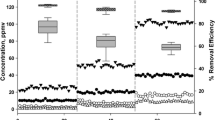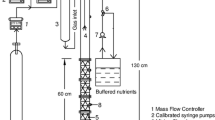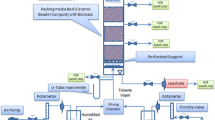Abstract
The main objective of this study was to evaluate the degradation of a ternary mixture of n-hexane, benzene, and methanol fed to two Trickle Bed Air Biofilters (TBABs) designated as “A” and “B”. Both TBABs were loaded with pelletized diatomaceous earth support media and run at an empty bed residence time (EBRT) of 120 s. TBABs “A” and “B” were operated at pH 4 and fed with n-hexane:benzene:methanol (CH:CB:CM) concentrations ratios of 1:3:10 and 1:3:6.6, respectively under different loading rates. The influent total loading rates varied from 39.2 to 117.7 g/m3h and from 32 to 96.4 g/m3h for TBABs “A” and “B”, respectively. In both TBABs, methanol and benzene were the most eliminated volatile organic compounds (VOCs), while the removal of n-hexane was controlled by the VOCs ratios. Higher removal efficiencies were obtained for the VOCs ratio of 1:3:6.6 corresponding to a total VOCs load of 96.4 g/m3h. The addition of VOCs mixture to the TBABs resulted in change of the fungi community within the TBABs as compared to the fungi community when the TBABs were previously receiving only n-hexane as a sole substrate.






Similar content being viewed by others
References
Babbitt, C. W., Pacheco, A., & Lindner, A. S. (2009). Methanol removal efficiency and bacterial diversity of an activated carbon biofilter. Bioresource Technology, 100, 6207–6216.
Balasubramanian, P., Philip, L., & Bhallamudi, S. M. (2012). Biotrickling filtration of VOC emissions from pharmaceutical industries. Chemical Engineering Journal, 209, 102–112.
Borin, S., Marzorati, M., Brusetti, L., Zilli, M., Cherif, H., Hassen, A., Converti, A., Sorlini, C., & Daffonchio, D. (2006). Microbial succession in a compost-packed biofilter treating benzene-contaminated air. Biodegradation, 17(2), 79–89.
Cai, Z. L., Kim, D., & Sorial, G. A. (2004). Evaluation of trickle-bed air biofilter performance for MEK removal. Journal of Hazardous Materials, 114, 153–158.
Chan, W. C., & Lai, Y. Z. (2008). Kinetic characteristics of n-butyl alcohol and iso-butyl alcohol in a composite bead air biofilter. Bioresource Technology, 99, 4380–4385.
Chang, K., & Lu, C. Y. (2003). Biofiltration of toluene and acetone mixtures by a trickle-bed air biofilter. World Journal of Microbiology & Biotechnology, 19, 791–798.
Dorado, A. D., Baquerizo, G., Maestre, J. P., Gamisans, X., Gabriel, D., & Lafuente, J. (2008). Modeling of a bacterial and fungal biofilter applied to toluene abatement: kinetic parameters estimation and model validation. Chemical Engineering Journal, 140, 52–61.
Eaton, A.D. & Franson, M.A.H. (2005). Standard methods for the examination of water & wastewater
Flickinger, M.C. & Drew, S.W. (1999). Encyclopedia of bioprocess technology. John Wiley.
Hassan, A. A., & Sorial, G. (2009). Biological treatment of benzene in a controlled trickle bed air biofilter. Chemosphere, 75, 1315–1321.
Hassan, A. A., & Sorial, G. A. (2010a). Biofiltration of n-hexane in the presence of benzene vapors. Journal of Chemical Technology and Biotechnology, 85, 371–377.
Hassan, A. A., & Sorial, G. A. (2010b). A comparative study for destruction of n-hexane in Trickle Bed Air Biofilters. Chemical Engineering Journal, 162, 227–233.
Kim, D., Cai, Z. G., & Sorial, G. A. (2005a). Behavior of trickle-bed air biofilter for toluene removal: effect of non-use periods. Environmental Progress, 24, 155–161.
Kim, D., Cai, Z. L., & Sorial, G. A. (2005b). Evaluation of trickle-bed air biofilter performance under periodic stressed operating conditions as a function of styrene loading. Journal of the Air & Waste Management Association, 55, 200–209.
Kim, D., Cai, Z. L., Sorial, G. A., Shin, H., & Knaebel, K. (2007). Integrated treatment scheme of a biofilter preceded by a two-bed cyclic adsorption unit treating dynamic toluene loading. Chemical Engineering Journal, 130, 45–52.
Koutinas, M., Peeva, L. G., & Livingston, A. G. (2005). An attempt to compare the performance of bioscrubbers and biotrickling filters for degradation of ethyl acetate in gas streams. Journal of Chemical Technology and Biotechnology, 80, 1252–1260.
Mudliar, S., Giri, B., Padoley, K., Satpute, D., Dixit, R., Bhatt, P., Pandey, R., Juwarkar, A., & Vaidya, A. (2010). Bioreactors for treatment of VOCs and odours—a review. Journal of Environmental Management, 91, 1039–1054.
Paca, J., Klapkova, E., Halecky, M., Jones, K., & Soccol, C. R. (2007). Performance evaluation of a biotrickling filter degrading mixtures of hydrophobic and hydrophilic compounds. Clean Technologies and Environmental Policy, 9, 69–74.
Rittmann, B. E., & McCarty, P. L. (2001). Environmental biotechnology. New York: McGraw Hill.
Sempere, F., Martinez-Soria, V., Penya-roja, J. M., Izquierdo, M., Palau, J., & Gabaldon, C. (2010). Comparison between laboratory and pilot biotrickling filtration of air emissions from painting and wood finishing. Journal of Chemical Technology and Biotechnology, 85, 364–370.
Sercu, B., Boon, N., Beken, S. V., Verstraete, W., & Van Langenhove, H. (2007). Performance and microbial analysis of defined and non-defined inocula for the removal of dimethyl sulfide in a biotrickling filter. Biotechnology and Bioengineering, 96, 661–672.
Soeta, N., Terashima, M., Gotoh, M., Mori, S., Nishiyama, K., Ishioka, K., Kaneko, H., & Suzutani, T. (2009). An improved rapid quantitative detection and identification method for a wide range of fungi. Journal of Medical Microbiology, 58, 1037–1044.
Symons, J.M. & McKinney, R.E. (1958). The biochemistry of nitrogen in the synthesis of activated sludge. Sewage and Industrial Wastes 874–890.
Tresse, O., Lorrain, M. J., & Rho, D. (2002). Population dynamics of free-floating and attached bacteria in a styrene-degrading biotrickling filter analyzed by denaturing gradient gel electrophoresis. Applied Microbiology and Biotechnology, 59, 585–590.
US. EPA (1990). The clean air act amendments of 1990 list of hazardous air pollutants. http://www.epa.gov/ttnatw01/orig189.html. Accessed 20th Feburary 2014.
US. EPA (2011). Air quality trends. http://www.epa.gov/airtrends/aqtrends.html#comparison.Accessed 20th Feburary 2014.
US.EPA (2013). Superfund chemical data matrix (SCDM); Part 5: chemical-specific parameters. Http://www.epa.gov/superfund/health/conmedia/soil/pdfs/part5.pdf. Accessed 20th Feburary 2014.
Verschueren, K. (2001). Handbook of environmental data on organic chemicals: Vol. 1. John Wiley and Sons, Inc.
Wypych, G. (2001). Handbook of solvents. ChemTec Publishing.
Yang, C. P., Chen, F. Y., Luo, S. L., **e, G. X., Zeng, G. M., & Fan, C. Z. (2010). Effects of surfactants and salt on Henry’s constant of n-hexane. Journal of Hazardous Materials, 175, 187–192.
Zehraoui, A., Hassan, A. A., & Sorial, G. A. (2012). Effect of methanol on the biofiltration of n-hexane. Journal of Hazardous Materials, 219, 176–182.
Zehraoui, A., Hassan, A. A., & Sorial, G. A. (2013). Biological treatment of n-hexane and methanol in trickle bed air biofilters under acidic conditions. Biochemical Engineering Journal, 77, 129–135.
Zehraoui, A., Kapoor, V., Wendell, D. & Sorial, G.A. (2014a) Alternate use effect of methanol on n-hexane biofiltration and microbial community structure diversity. Biochemical Engineering Journal In press.
Zehraoui, A., Wendell, D. & Sorial, G.A. (2014b). Comparison study of treatment of hydrophobic vocs in trickling bed air biofilter: emphasis on long term effect of initial alternate use of hydrophilic VOCs. Journal of Air & Waste Management Association Under review.
Acknowledgments
The authors would like to thank the financial support from National Science Foundation under award number CBET 0852803. The finding and conclusions expressed in this publication are solely those of the authors and do not necessary reflect the views of the Foundation.
Author information
Authors and Affiliations
Corresponding author
Rights and permissions
About this article
Cite this article
Zehraoui, A., Wendell, D. & Sorial, G.A. Biodegradation of a Ternary Mixture of Hydrophobic and Hydrophilic VOCs in Trickle Bed Air Biofilters. Water Air Soil Pollut 225, 2075 (2014). https://doi.org/10.1007/s11270-014-2075-x
Received:
Accepted:
Published:
DOI: https://doi.org/10.1007/s11270-014-2075-x




